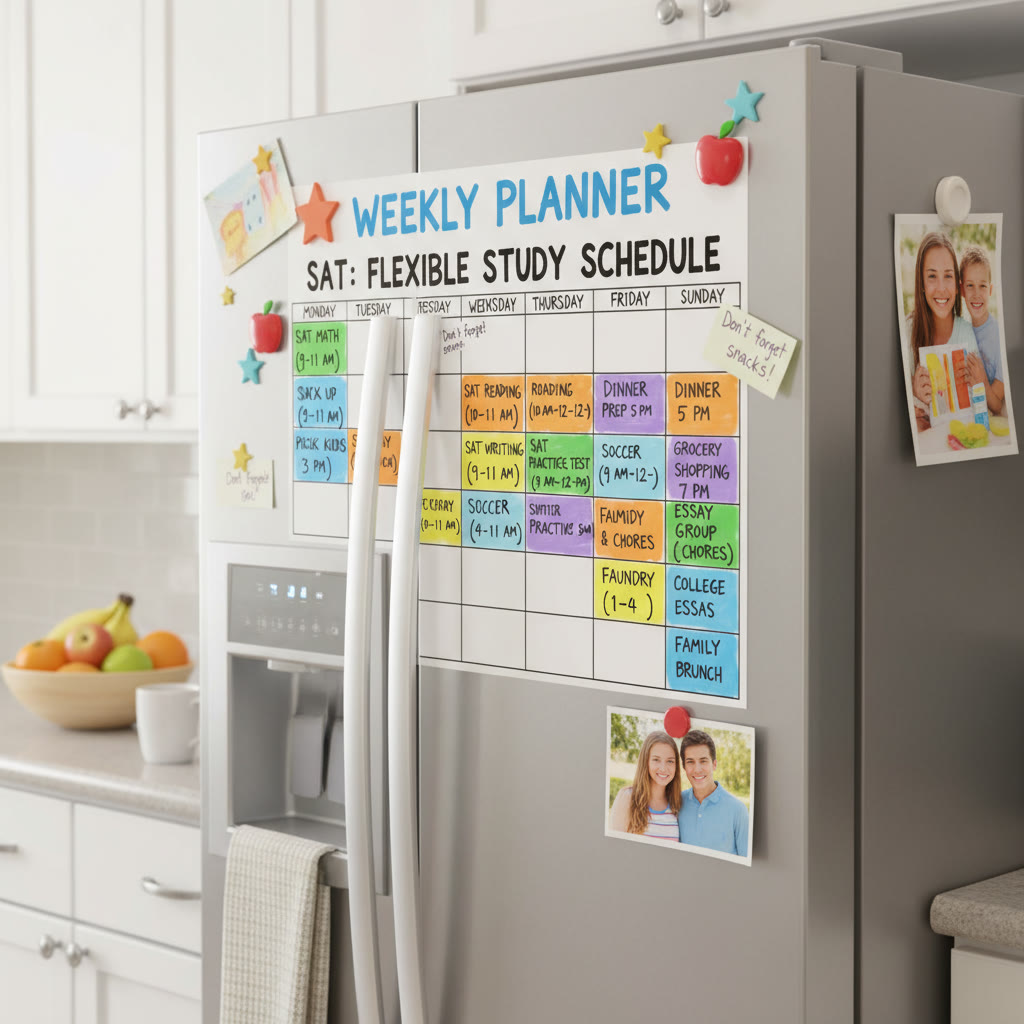You’re Not Alone: Why Balancing SAT Prep and Family Life Feels Impossible
When you open a prep book or a practice test, the quiet optimism of “I’ll get through one section” bumps up against the loud realities of family: younger siblings needing help with homework, a parent asking for errands, chores that never end, or a part-time job you promised you’d keep. It’s normal to feel stretched thin — and it’s fixable.
This post is for the student who wants a strong SAT score but also wants to keep family life intact. You’ll find human, practical strategies (no miracle cures) to help you study smarter, not harder. There are examples, a sample weekly plan, a few simple tables, and tips on keeping your head clear. I’ll also show where personalized support — like Sparkl’s 1-on-1 tutoring and tailored study plans — can slot into a real-life schedule so you don’t waste time on what won’t move your score.
Start With the Right Mindset
Quality over Quantity
Two hours of distracted study while half-listening to the television is often less effective than thirty focused minutes. When family life is busy, focus on the quality of your study sessions. That means selecting high-impact activities (practice tests, focused review of mistakes, timed sections) and protecting blocks of time where you can concentrate.
Accept Imperfection — and Plan Around It
No one studies perfectly every day. Weekly rhythms change: birthdays, extra shifts, sick relatives. Build a plan that expects interruptions. If your schedule has built-in flexibility, missed sessions are easier to recover. Treat your plan like a living document, not a list of ultimatums.
Practical Strategies to Carve Out Real Study Time
Do a Time Audit — Honestly
Spend three days logging how you actually use time in 15–30 minute chunks. Note school, chores, commuting, family obligations, screen time, and naps. The goal is not to shame yourself — it’s to find pockets of real time. Often there’s an hour scattered across the day that can be combined into one focused session.
Build a Flexible Weekly Plan
Instead of rigid daily schedules, construct a weekly framework that marks high-priority study blocks and flexible recovery slots. Put test-like activities (timed sections, full practice test) in the most reliable window — maybe Sunday morning when siblings are away — and sprinkle shorter sessions during unpredictable times.
Use Micro-Study Sessions
- 5–15 minute drills for vocabulary or grammar rules while waiting for dinner to finish.
- 25-minute focused Pomodoro sessions for problem sets with a 5–10 minute break for chores or check-ins.
- Use “transition times” — waiting for a family member at an appointment — for flashcards or a reading passage.
Micro-sessions add up. Consistent short practice is particularly effective for memorization and maintaining momentum.
Prioritize High-Yield Activities
When time is limited, focus on the tasks that most reliably increase your score:
- Full or sectional timed practice tests to build stamina and pacing.
- Analyzing mistakes: understanding why you missed a question is more valuable than repeating practice.
- Targeted practice on weak areas (e.g., data interpretation or grammar rules).
Sample Weekly Schedule: Balancing Family Commitments and SAT Prep
| Day | Reliable Family Commitments | Focused Study Slot | Micro-Study Opportunities |
|---|---|---|---|
| Monday | After-school tutoring for younger sibling (4–6pm) | 7:30–9:00pm — Math problem set (timed practice) | Morning commute flashcards; 10-minute grammar review after dinner |
| Tuesday | Family dinner + chores (6–8pm) | 8:30–9:15pm — Reading passage practice (two sections) | 15-minute vocabulary drill while making breakfast |
| Wednesday | Part-time job shift (5–9pm) | Lunch break — 30-minute focused algebra review | Evening: 10-minute error log review before bed |
| Thursday | Family errands (afternoon) | 7:00–8:30pm — Practice test section (Writing & Language) | Commute: reading comprehension flash problem |
| Friday | Free night — family movie (optional) | 6:00–8:30pm — Half-length practice test (optional) | Short review of mistakes from the week |
| Saturday | Weekend chores + family time (variable) | 9:00–11:30am — Full practice test (timed) | Evening: 20-minute review of test mistakes |
| Sunday | Family meals and planning (afternoon) | 4:00–5:00pm — Targeted question sets (weak areas) | Morning: 15-minute spaced repetition flashcards |
This sample shows how a student with family responsibilities can anchor big activities on the most predictable day (Saturday practice test) and spread smaller, tactical sessions throughout the week. The exact times will differ — the principle is to pair the most demanding tasks with the most likely uninterrupted windows.
Work With Your Family, Not Against It
Communicate with Empathy
Tell your family what you need and why. Explaining that a weekend morning practice test is like training for a real exam makes sense to most households. Use specific requests: “I need 2.5 hours Saturday morning to do a practice test; could you handle breakfast?” The clearer and shorter the ask, the better the response.
Create Shared Rules
- Agree on study windows when interruptions are minimized.
- Offer a trade-off: you’ll do an extra chore in exchange for protected study time.
- Use visual cues at home: headphones on = studying, or a small sign on the door for serious sections.
Family members are usually willing to help when they see how concrete the plan is.
Study Techniques That Respect Your Time
Active Recall and Spaced Repetition
Active recall (trying to retrieve information from memory) beats passive review. Use short, frequent flashcard sessions for vocabulary, grammar rules, and math formulas. Spaced repetition — reviewing cards just as you’re about to forget — maximizes retention with minimal time.
Practice Tests: Quality Over Quantity
Take full-length tests under realistic conditions every 1–2 weeks as you get closer to the exam. If family responsibilities prevent long uninterrupted stretches, take sectional timed tests instead, then simulate a full test occasionally when you can secure uninterrupted time.
Error Logs and Targeted Review
Keeping an error log — a simple spreadsheet or notebook with the question type, why you missed it, and how to fix it — turns each practice mistake into a learning opportunity. After a practice session, spend 20–30 minutes repairing errors; that targeted review is highly efficient.
When to Bring in Personalized Help
Personalized tutoring becomes especially valuable when your time is scarce. A good tutor — or Sparkl’s personalized tutoring — helps you zero in on what matters most: they provide 1-on-1 guidance, tailor study plans to your real-time availability, and use expert insight (plus AI-driven analytics) to focus practice where it yields the most points. If you’re spending hours on content that doesn’t move your score, a few focused sessions can reorient your effort.
Image Ideas


Managing Stress, Sleep, and Energy
Sleep Is Not Optional
Skipping sleep to cram is a false economy. Memory consolidation happens during sleep, and fatigue ruins concentration. Aim for consistent bedtimes. If you must study late occasionally, schedule a short nap earlier in the day or reduce cognitive load the next morning.
Small Habits That Make a Big Difference
- Hydrate and eat proteins during heavy study sessions to avoid mid-session crashes.
- Move your body for 10 minutes between sections to restore focus.
- Use breathing techniques (box breathing or simple 4-4-4) when anxiety spikes.
Celebrate Small Wins
Recognize progress: a clean error log, faster pacing on a section, or a corrected concept. Celebrating micro-wins keeps motivation up and makes it easier to balance family needs with studying long-term.
When Family Responsibilities Spike: Short-Term Triage
Emergency Week Checklist
- Temporarily reduce study goals to maintenance: 30–60 minutes daily focused review rather than building new content.
- Prioritize sleep and nutrition — crisis weeks are not for pushing cognitive limits.
- Shift heavier prep to a day with predictable quiet or move an intense study block to early morning.
Rescheduling and Realism
If family obligations make your original test date unrealistic, consider rescheduling rather than going in underprepared. This is not quitting — it’s a strategic choice. If changing dates isn’t possible, focus on maximizing score improvements in small, targeted ways and consider bringing in targeted tutoring to accelerate gains.
Real-Life Mini Case Studies
Case A: The Student Caregiver
Maria helps take care of her younger sibling for two hours after school and has a part-time job on weekends. She switched to micro-sessions: 20-minute focused blocks after dinner and a protected two-hour slot Saturday morning for a full practice test. Maria used an error log and met with a Sparkl tutor once a week to keep her plan targeted. Within two months she improved pacing and reduced careless errors.
Case B: The Working Student
Jason works evenings three times a week. He moved intensive study to his days off and used commuting time for flashcards and short problem sets. He scheduled full-length tests during school breaks and focused on eliminating weaknesses identified by a tutor. This allowed him to balance income needs and steady test prep progress.
Case C: The Busy Sibling Helper
Lina manages chores for her household and wanted to keep family harmony. She negotiated protected study hours with her parents and swapped some chores for study-covered family time. She used AI-driven insights from a tutoring service to prioritize weak skills. The result: steady, less-stress progress without family friction.
Quick Reference: What to Do This Week
- Do a 3-day time audit and find 3 reliable weekly blocks you can protect.
- Schedule one full or half practice test during a predictable time (Saturday or a break day).
- Start an error log today — review it for 20 minutes after each practice session.
- Try micro-sessions: three 20–25 minute focused blocks rather than one 2-hour distracted block.
- Talk to your family with one clear request and a small trade-off.
- If you’re short on time, consider targeted 1-on-1 tutoring (like Sparkl’s) to accelerate progress.
Final Thoughts: Small Consistent Choices Win
Balancing SAT prep with family responsibilities isn’t about heroically doing everything. It’s about designing a plan that respects your life while pushing your score forward. Small, focused sessions, honest communication at home, and effective review habits will get you far. When your time is limited, targeted help from an expert tutor or an AI-augmented program can multiply your results by ensuring every minute counts.
Remember: family obligations show your maturity and responsibility—qualities the admissions process values. You can both support your family and prepare for the SAT. With a realistic plan, compassionate communication, and smart study choices (plus occasional tailored help like Sparkl’s personalized tutoring when you need it), you’ll move forward without losing balance.
Take one small step this week: block a protected 60–90 minute study session, tell your family what you’re doing, and use that time for a single, high-impact task. That handful of hours repeated across weeks is what builds confidence, skill, and score. You’ve got this.















No Comments
Leave a comment Cancel